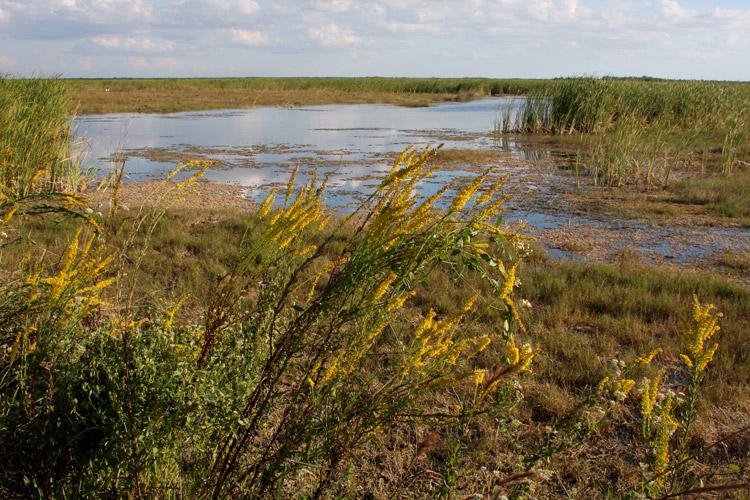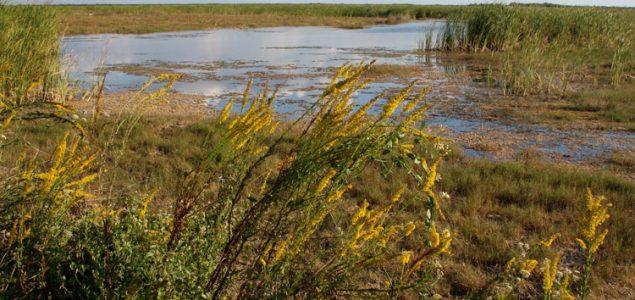Like a lover it calls me. I rush down the road to uncover its secrets. But it eludes me. I come away with bits and pieces: a cardinal air plant flashing red in the dim surroundings, newborn alligators, their eyes barely open, sliding by in the duckweed.
The Fakahatchee Strand has been called the “Amazon of North America” with good reason. The only royal palm/cypress forest on earth, it’s a dense landscape where tropical meets temperate, where bald cypress, royal palms and pond apple mingle with red maples and pop ash.
Trees blazed with orange and white lichen are host to dozens of air plants. Sword ferns lie in great swaths along the edges of Janes Scenic Drive, the 11-mile long dirt road through the swamp. Further in, huge leather ferns stick up high above the fray. Alligator flag and duckweed carpet the water, which can be chest deep in the rainy season or reduced to mud puddles during the dry. Vines, some as thick as a man’s arm, tie everything together.
A rich repository of south Florida flora, each visit has a theme: grass pinks in May; string lilies in summer, maples turning red in fall, swallowtail butterflies courting in the last rays of the setting sun and one winter evening, in the distance, a big cat with a long tail.
See any alligators?” occupants of a passing car will stop to ask. “Yep, down the road near a culvert!” I tell them. “ Panthers?” “Not even tracks”.
Actually in recent years the big cats have made a remarkable comeback. According to biologist Deborah Jantzen, who’s been working on the Panther project. In 1995, there were about 50 left, many fewer than that in the Fakahatchee. Now the population hovers around 120 thanks to an infusion of genes from 8 female cougars imported from Texas. Radio collars monitor the animals in the Fakahatchee, neighboring Big Cypress Preserve and Panther Preserve. There’s not enough room for these top predators; males require 140 square miles to thrive and will fight to the death in competition for the females.
There are two entry points to the park. Big Cypress Bend Boardwalk off Route 41 runs through 215 acres of the virgin swamp preserved by the Norris family who refused to sell out to the loggers. Day-old tendrils of poison ivy curl up the weathered trunks of bald cypress, 600 years old and only the eighth generation to grow after the seas receded. While tourists rush down the boardwalk to snap a few pictures I lean over the rail to look at lichen ”painted “on practically every tree. They attest to the cleanliness of the air and the pristine clear water flowing from the north, which has taken a year to get here.
The other entry, Janes Scenic Drive off Route 29 in Copeland, runs through the center of the strand. Often, I’ll stop in on the way home from Miami. Once at last light I saw what I thought was a bear but as I got closer, it was a man, clothed all in black, dodging behind trees as my van approached. I made a U turn and called it a day.
Here, even the commonplace becomes mysterious. Blooms of the humble buttonbush are transformed into planets revolving around some distant sun. Native coco plum grows to magnificent proportions, many times bigger than the one in front of my house. Morning glories anyone can grow from a packet of seeds seem as alluring as the rarest of orchids, which there are plenty of–50 native orchids, more than any place in North America.
On each visit I think, “This is as close as I’ll get to eternity”. By geological standards, the land is brand new. The tip of Florida peninsula emerged from the seas only about five thousand years ago and this swamp is 70 years into its second growth.
In the 1940s and 50s, the Lee-Tidewater Cypress Company logged out the huge bald cypress for shipbuilding, coffins and pickle barrels. The company built a grid of narrow-gauge railroad tracks to haul the trees out. When the logging was completed, they pulled up the rails; these old tramways became the hiking trails through the park.
These days, a few people still live here in tumble down cottages on “grandfathered in” parcels. Once I ran into a guy driving an old camper and stopped to enthuse about the place with him. I was startled when to my exclamations of “ Beautiful!”, he shouted “Ugly Ugly!” He had fenced in his spread and put in a “real” garden with a proper lawn, crape myrtles, bougainvillea and fruit and nut trees—all from faraway places.
The strand, which is part of the 78,000-acre Fakahatchee Strand Preserve State Park, is only twenty miles long and five miles wide but it’s daunting. I stay tethered to the road. Without compass or guide, a casual visitor stepping into the swamp risks getting lost.
It’s Mike Owen’s back yard. The park’s biologist for almost 25 years, he knows the hidden nooks and crannies of the place including “the cathedral”, a grove of royal palms.
My first visit, I followed the map and tried to find my way out through the Picayune State Forest to the north. I circled round and round the Picayune with its canals and vacant lots which are underwater half the year. Lots had been sold off sight unseen to ignorant Northerners who later abandoned them. Finally, Leonardo, fishing in one of the canals, led me out of the maze.
Winter is the best time to see into the swamp. With the leaves off the cypress, details emerge–wild pine air plants spread out on bare branches against a blue sky, myrsine and dahoon holly with bright red berries, a pileated woodpecker hammering on a snag that, years ago, might have provided a roost for its cousin, the ivory billed woodpecker, now thought to be extinct.
On a fall evening after a very wet summer, the water is higher than I’ve ever seen it. I’ve brought a friend. As we turn onto the drive, a black bear lopes across the prairie into a stand of trees. Then, we come upon a cottonmouth spread across the road, reminding us we might meet one day when we’re knee deep in the muck on a guided swamp walk. Though he’s quiet, bulging with a recent meal, my passenger shivers and hunches down in her seat. Barred owls drop in, curious to see visitors.
Sometimes I feel the presence of the indigenous peoples. Surely some of these ancient snags rotting in the muck in their prime provided cover for the Calusa who hunted alligators and bears 500 years ago. Years later, settlers came in wagons on a Sunday afternoon to collect orchids and bromeliads. Poaching has always gone on in this place.
So has collecting. New York Botanical Garden Curator John Kunkel Small visited in the early 1900s. So did A.A. Eaton. In the 1950s, Cal Stone established hunting camps. In the ‘70s and ‘80s botanists Carl Luer and John Beckner sought out native orchids.
John had always had a special fascination for the place. He’d been coming to the “Fekahatchee” since the 1950’s when the logging was still going on. He saw the huge trees felled, chained and dragged across the terrain crushing everything in its path, even injured workers who were left to lie where they fell.
The first time I walked the boardwalk I ran into Dutch researchers taking core samples in the swamp as part of their study of global warming. Years later I met them again in a peat bog at the Horton Ranch. It was John Beckner who brought us together. He had known Emmy Lammertsma from years before, when she was a graduate student from the University of Utrecht doing research here.
John and I visited often. He’d point out two species of wild coffee growing side by side, the leaves of one dull, the other shiny. A witches broom nestled in the crook of a pop ash. And most alluring, tiny orchids perched on tree trunks like woodpeckers, An orchid expert, John knew the flora well and had led field trips here, while working at Marie Selby Gardens. He had theories about how some plants got here. Seeds from Cuban royal palms arrived in the canoes of indigenous people 2000 years ago. Cypress seedlings were blown in by winds from Mexico 3500 years ago.
The place was a tonic for him. Although he was close to eighty, he scampered down the trails, with Mike Owen. They enthused over each orchid they found, which Mike penciled in a tiny notebook while I photographed. “Fran, over here” they called out over and over. Within a space of a few hours, we found 12, not bad for a day in December.
The swamp provides the perfect climate for orchids–steamy in summer when many of them –including the fabled ghost orchid—bloom, and warm through even in the biggest chills winter has to offer South Florida. Frosts, increasingly rare, can’t penetrate very far into the swamp even though on nearby prairies, wind chills the bones.
As John lay dying, he talked about A.A. Eaton trekking though the Fakahatchee. I was left to discover the details on my own. A self-taught botanist from New England Alvah Augustus Eaton botanized the strand, then in its pristine state, during the springs of 1903, ’04 and ‘06. Reportedly a frail man, he managed these almost impossible feats without cell phone or GPS, driven by his obsession with ferns. He found plenty to excite him. Sadly, some he discovered back then are today rare or endangered.
The Fakahatchee inhabits my dreams. A moonflower opens in the darkness. The panther moves through the swamp.

